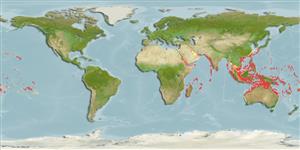Common names from other countries
Environment: milieu / climate zone / depth range / distribution range
экология
морской ассоциированный с рифами; пределы глубины 3 - 60 m (Ref. 1602), usually 5 - 50 m (Ref. 27115). Tropical; 24°C - 28°C (Ref. 27115); 32°N - 35°S, 24°E - 132°W
Indo-Pacific: Red Sea and East Africa to Samoa and the Tuamoto Islands, north to southern Japan.
Size / Вес / Возраст
Maturity: Lm ? range ? - ? cm
Max length : 22.0 cm TL самец/пол неопределен; (Ref. 4392)
колючие лучи спинного плавника (общее число) : 9; членистые (мягкие) лучи спинного плавника (общее число) : 11 - 13; колючие лучи анального плавника: 3; членистые (мягкие) лучи анального плавника: 11 - 13. Ground color of female very dark brown; orangish on front of head and lower parts; body spotted with white or very pale yellow, extending to dorsal and anal fins; caudal bright cadmium. Male form deep violet; irregular blue spots on cheeks and lower operculum; body with round blue spots becoming oblong, nearly forming longitudinal bands ventrally; dorsal and anal fins with longitudinal bands; caudal with numerous blue ocelli. Dorsal spines flexible. Caudal fin of adults truncate to emarginate; rounded in small juveniles. Easily confused with male A. geographicus when seen underwater, except when displaying with iridescent blue-green lines and spots over the body and fins (Ref. 48636).
Adults are found in areas of mixed coral, rubble, consolidated limestone, and sand of seaward reefs; also in soft coral or sponge habitats (Ref. 48636). Oviparous, distinct pairing during breeding (Ref. 205). Minimum depth reported taken from Ref. 30874.
Life cycle and mating behavior
Maturities | размножение | Spawnings | Egg(s) | Fecundities | личинки
Oviparous, distinct pairing during breeding (Ref. 205).
Randall, J.E., 1972. A revision of the labrid fish genus Anampses. Micronesica 8(1-2):151-190. (Ref. 2677)
Статус Красного Списка МСОП (Ref. 130435)
CITES (Ref. 128078)
Not Evaluated
Угроза для людей
Harmless
Использование человеком
рыболовство: не имеет хозяйственного значения; аквариум: коммерческий
дополнительная информация
инструменты
Специальные отчеты
Скачать в формате XML
ресурсы в Интернет
Estimates based on models
Preferred temperature (Ref.
115969): 24.3 - 29, mean 27.6 (based on 1474 cells).
Phylogenetic diversity index (Ref.
82804): PD
50 = 0.5002 [Uniqueness, from 0.5 = low to 2.0 = high].
Bayesian length-weight: a=0.00977 (0.00470 - 0.02030), b=3.07 (2.89 - 3.25), in cm Total Length, based on LWR estimates for this (Sub)family-body shape (Ref.
93245).
Trophic level (Ref.
69278): 3.5 ±0.37 se; based on food items.
устойчивость к внешним воздействиям (Ref.
120179): средний (среднего размера), минимальное время удвоения популяции 1.4-4.4 года (Preliminary K or Fecundity.).
Fishing Vulnerability (Ref.
59153): Low vulnerability (12 of 100).
